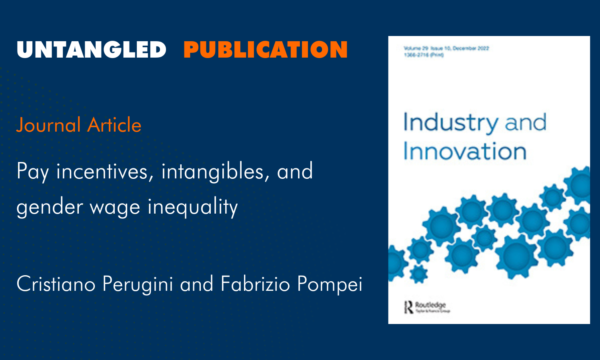

NEWS

An UNTANGLED paper by Cristiano Perugini and Fabrizio Pompei on the impact of performance-based remuneration on the gender pay gap has recently been published in Industry and Innovation Journal.
Incentive pay schemes (IPS) are remuneration policies that link an employee’s salary to their performance and the achievement of specific objectives. An increasing number of companies are adopting these policies to motivate employees and enhance organisational performance. While IPS tend to widen wage disparities within firms, scholars and policymakers have expressed concern that their growing popularity might exacerbate the gender pay gap. However, Perugini and Pompei’s study reveals that companies implementing IPS actually experience a narrower pay gap between female and male employees. Nevertheless, the effect is absent in companies that invest heavily in technology and intangible assets.
The researchers analysed the salaries of over 6 million workers employed in 142,251 companies across Germany, France, Italy, Spain, and the UK. They found that female workers, who constituted 47% of the sample, earned on average 12.5% less than their male counterparts. The firm-level gender pay gap was most pronounced in the UK, at 16%, while it was narrowest in Italy, at 9.5%. When combining this data with information on IPS adoption, Perugini and Pompei discovered that a higher prevalence of IPS correlated with a narrower gender pay gap.
“There are a number of factors that can trigger a wage gap, and in our analysis we controlled for their impact,” said Perugini. “In companies with performance-based remuneration the pay gap shrinks. This is probably because these companies attract a specific type of female worker, that is women who have similar skills, potential and ambitions to men, and who face fewer constraints related to household responsibilities. Additionally, these employers tend to have more effective screening and monitoring tools to prevent discrimination.”
Furthermore, Perugini and Pompei found that IPS are more commonly adopted by innovative organisations, where incentivising worker performance is crucial for success. However, the positive impact of IPS on narrowing the gender pay gap varies by industry and is related to investment in information and communication technology (ICT) and intangible assets. The pay gap narrows primarily in firms that invest less in technology.
The authors highlight that more substantial investments in ICT, research and development (R&D), and brand development often result in unpredictable working hours, making it harder for women to balance work and household responsibilities. Consequently, their chances of meeting their targets decrease, and female employees earn less than their male co-workers.
“Our study suggests that it’s not IPS themselves that worsen gender pay inequality, but rather the specific technological context in which they are implemented,” said Pompei. “This underscores the need for policy measures aimed at redistributing unpaid work responsibilities between genders, as proposed by the Work-Life Balance Directive.”
Cristiano Perugini & Fabrizio Pompei (2023) Pay incentives, intangibles, and gender wage inequality, Industry and Innovation, DOI: 10.1080/13662716.2023.2254264